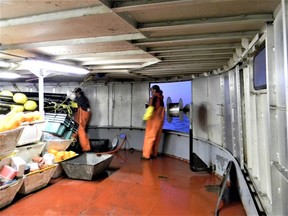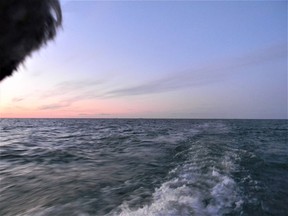
“I love that you get to see the sun come up. It really doesn’t feel like a job. I’m with my family. It’s in the blood.”
–Curtis Mummery, crewman on the Lady Anna II, responding to the question: “What do you like best about commercial fishing?”
—
It’s about 6:25 am on Tuesday, March 29 on the pitch-black calm of Lake Erie. The Lady Anna II is pointed due south, about 10 miles due south of Kingsville and five miles northwest of the north shore of Pelee Island.
In the wheelhouse, Captain Mike Mummery has slowed the Lady Anna II to a one-knot crawl. Craig Adamson and Josh Mummery are at the starboard midship “picking” station, removing 2,000 pounds of pickerel from the more than one-third of a mile of net hauled aboard just 35 minutes ago.
James “Marty” Martin and Curtis Mummery stand by at the open sliding doors of the port stern hatch. “Marty” is facing the stern, just forward of the “roller”; a metal spool mounted vertically on a metal pole. At his feet are boxes loaded-up with 160-yard-long sections of empty, clean net. The end of one of those boxes of net is draped over the roller, towards the stern.

Curtis stands at the very stern of the Lady Anna II. In his hands is a flagged, marker buoy tied to a 30-pound net anchor that remains on the stern gunwale. That 30-pound net anchor is connected to the end of the section of net draped over the roller.
Curtis stares, intently and unmoving, towards the wheelhouse door. Except for the purr of the Cummins diesel and the drone of rock and roll music, all is quiet.
And then, almost as fast as the eye can see, Curtis heaves the marker buoy into the predawn pitch-black of Lake Erie. The first “set” of the day has started.
In a couple of seconds, the line connecting the marker buoy to the net anchor whirs over the steel gunwale and, just before that line goes taught, Curtis pitches the 30-pound net anchor off the gunwale into the frigid depths of Lake Erie. In about five seconds, the net anchor plummets through 35 feet of water and plows into the muddy ooze of Lake Erie’s clay bottom. A couple of seconds later, the line connecting the net anchor to the end of the first box of gill net goes taught.
The momentum of the 100-ton displacement of aluminum, steel, diesel engine, machinery and fresh-caught pickerel that is the Lady Anna II, tugs against the net anchor. Net spins over the roller, downbound into the depths.
“Marty’s” hands move as fast as he can move them – hand-over-hand, guiding the net over the roller, making sure it goes into the water untwisted.
As the 160 yards of net in one box comes to an end, Curtis – once again, almost as fast as the eye can see – connects it to the end of the next box of net, with a line connected to a 30-pound net anchor. Curtis walks this net anchor and its line back to the stern and, at just the right moment, heaves them into Lake Erie.
For 15 minutes a flurry of 640 yards of net, five net anchors, 24 “cans” and two marker buoys stream from the stern of the Lady Anna II. And in all the seeming confusion of lines and net anchors and net, hardly a word passes between “Marty” and Curtis – each knows exactly what the other must do.
At 6:40 am, Curtis slides the port stern hatch closed. The first set is done. “Marty” and Curtis join Craig and Josh picking fish from the nets brought aboard in the first “pull.”
It might have been the combination of darkness, calm water and Capt Mummery’s skilful handling of the Lady Anna II – I’m not sure. Even though I knew the Lady Anna II never stopped moving, I had absolutely no sense of where we were or what direction we were traveling in.
So about midway through the first set, I had the idea that I’d go to the wheelhouse to see what Captain Mummery was seeing and asking where we were. So I turned forward from the starboard midship position, where I had been photographing “Marty” and Curtis set the net. As I turned forward, toward the bow, the answer to a question that occurred to me when I first boarded the Lady Anna II, flashed into mind.


Bolted to the frame of the sliding door hatch that is the entrance to the wheelhouse, is a mirror that looks like it belongs on a tractor or small truck. Wherever it belongs, that mirror looks out of place on the Lady Anna II. But looks can be deceiving.
I came to realize that that mirror is exactly where it belongs and that it serves a very important purpose. Whenever the crew is setting net, Captain Mummery – silent and unseen in all the hum and glow of the wheelhouse’s electronic wizardry – watches that mirror like a hawk.
As soon as I understood the purpose of the mirror, I understood how dangerous the set I had watched could be. That if you were caught-up or tangled in anchor line or net streaming over the stern, you could easily be pulled over the gunwale and into the depths of Lake Erie. And that even if someone yelled out “Back Up” or “Man Overboard,” it would be difficult to stop the 100 tons of momentum and three-foot diameter propeller of the Lady Anna II.
I decided that I should not go to the wheelhouse until the set was finished. Turns out, that was a smart decision. And not only because Captain Mummery had to keep a sharp eye on “Marty” and Curtis as they set net.
As I later found out, the net was set in the Lake Erie shipping channel; that set of boundary lines on navigation charts that marks the course, where it’s normal to see 740-foot-long, 12,000-horsepower Great Lakes freighters cruising at 15 knots to and from the Detroit River. The largest of these ships – the 1,013-foot-long, 17,120-horsepower Paul R Tregurtha – cruises these waters. For all their size and power, these ships run very quiet. During the set, Captain Mummery had to be looking back towards the stern, at his radar and everywhere else on the horizon. Ever vigilant and like a hawk.
Seldom spoken, but never far from the surface, is the tragedy of March 18, 1991. Just 12 miles south of Captain Mummery’s hometown, Port Dover, in Long Point Bay, the Canadian Coast Guard Ship Griffon, ploughed – at its full speed of 11 ½ knots – into the Port Dover-based fishing vessel, Captain K.
At 60 feet long and 200 horsepower, the Captain K didn’t stand a chance against the Griffon’s icebreaker hull, 234 feet of length and 2,000 horsepower. The Griffon smashed-in the port wheelhouse area of the Captain K. In less than a minute, the Captain K – with his crew of three trapped in the wheelhouse – sank out of sight and plummeted 130 feet to the bottom of Lake Erie.
It’s about 6:45 am, the set is done. I climb up the two steps into the wheelhouse. The sun is still below the horizon, but the curtain of darkness is risen. Just above the horizon, glows a streak of red sky. Just below that streak, Point Pelee stretches pencil-line-thin and pancake-flat into Lake Erie to become the southernmost point of mainland Canada. The Lady Anna II is pointed north, toward home. But the work is only half done.
—
More from aboard the Lady Anna II in Part 4 of this story.
